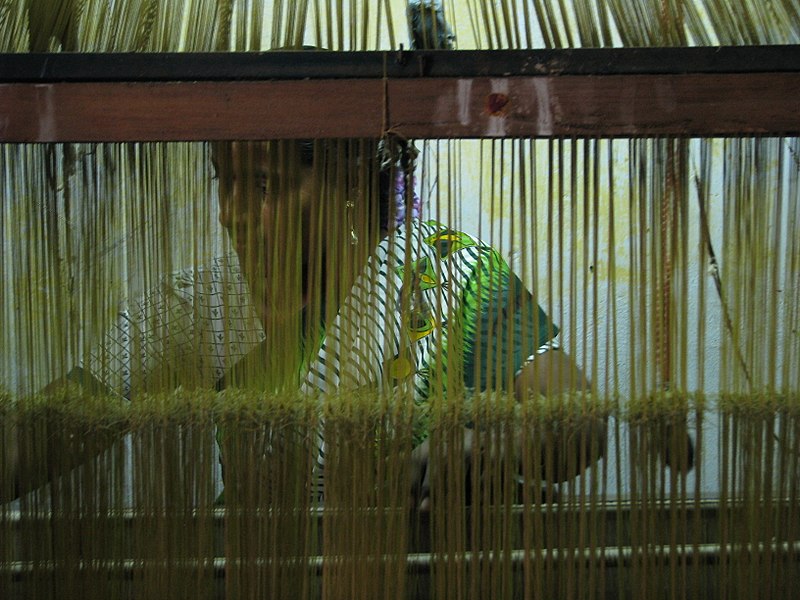There was a heavy wooden trunk that my grandmother owned contained her most precious possessions, her silk saree collection. I remember the teeming glow on her face as she would speak to me nostalgically about the particular events she had worn each saree. The saree she prized the most of all was a beautiful Tussar Silk saree, known in Sanskrit as the Kosa Silk saree. With its rich texture and natural gold overtones, Tussar Silk Sarees come in four varieties; Katia, Ghhichha, Thigh reeled and machine reeled.
The story of how it is produced is fascinating and I am sure you would like to know more.
How is Tussar Silk made?
Tussar Silk also called Kosa Silk is obtained from silk worms that breed in the wild on Sal and Saja trees. The species that produce the cocoon are Antheraea Mylitta, Antheraca Proylei, Antherea Pernyi and Antheraca Yamamai. The cocoon is boiled to extract the silk. While this is important aspect of the process, in many parts of India Tussar Silk is produced in a more nonviolent way i.e. cocoons are collected only after larvae have left them thus giving it yet another name, the Ahimsa Silk.
Jharkhand is famous for its sericulture and the tribals are renowned for their skills at weaving silk. Maharashtra, Andhra Pradesh, Bengal, Orissa and Chattisgarh also produce Tussar Silk.
What makes Tussar silk unique?
Tussar Silk sarees have a natural texture, gold overtones and are also more porous. This means that the fabric is breathable and it is comfortable to wear even during the summers.
How to Maintain a the fabric?
Tussar has shorter fibres than mulberry silk which makes it less durable. That is why; it is important to take special care of this fabric.
They are very delicate and it is recommended that you dry clean them. Never hang the sarees out in the sun as the colours might fade.
These sarees need to breathe, so it is advisable to not keep them in plastic bags. You can use simple cloth bags instead.
My top 5 favourite Tussar Silk Sarees are:
The Pinsaki
Craftsmanship at its best, I love the contrast colours and the pretty border used to make this Tussar Silk look contemporary and stylish.
The Rajivakshi
The traditional green and gold combination coupled with the pretty motifs, the Rajivakshi is inspired by nature. A beautiful saree for all occasions.
The Ravipriya
Beige and gold is a classic and an elegant combination which has been given a little pop of colour through its pretty pink border!
The Dweepa
The sarees are being given a modern touch by printing modern art, animals and floral prints. Dweepa showcases a true blend of traditional colours and modern designs.
The Ekavaktra
A pure raw silk saree in grey is truly unique and therefore makes a great style statement at family gatherings. It breaks away from the traditional colours by blending specks of dull red around the pallu. I must say, I am partial to this one.
Nature inspired motifs, delicate hand embroidery and a fabric that is airy and comfortable, Tussar Silk sarees are perfect for every occasion. I have one in my wardrobe, would you like to get one, too?
You could read more about Bharatsthali’s unique collection of sarees here.
Have any questions about Tussar silk? Let me know in the comments below.
image credits: Wikimedia Commons





 We remember the day seven years back when were travelling in a Mumbai local trying hard to come up withe a name for our blog when struck us; Khushboo was always called a Jack of all Trades. The name stuck (with a slight modification, of course) and Minni was born. Six years, over 100 collaboration, lakhs of readers and several awards later; our love for blogging continues to grow. We continue to write on an eclectic range of topics from the funniest autorickshaw signs that we have spotted in Mumbai to how to bathe an elephant. We are true blue Munni of all Trades and we hope to continue on this joyride with our fellow Munnies and Munnas.
We remember the day seven years back when were travelling in a Mumbai local trying hard to come up withe a name for our blog when struck us; Khushboo was always called a Jack of all Trades. The name stuck (with a slight modification, of course) and Minni was born. Six years, over 100 collaboration, lakhs of readers and several awards later; our love for blogging continues to grow. We continue to write on an eclectic range of topics from the funniest autorickshaw signs that we have spotted in Mumbai to how to bathe an elephant. We are true blue Munni of all Trades and we hope to continue on this joyride with our fellow Munnies and Munnas. 